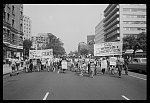This digital image file is titled, “Women’s lib[eration] march from Farrugut Sq[uare] to Layfette [i.e., Lafayette] P[ar]k / [WKL].” This image was captured by Warren K. Leffler on August 26, 1970. The black and white photograph pictures, “Women carrying banners and signs while marching down a street in Washington, D.C., during a demonstration in favor of equal rights for women”(())
Throughout the history of the United States, different minority groups have struggled, and are still fighting for equality, one of these groups being women. While women were granted the right to vote in 1920, this change did not solve the deeper issue of discrimination against women (()) In the late 1970’s a more radical form of feminism emerged from the younger generation. This group of “radical” feminist not only fought for equality in the workplaces, fought to be freed from all shapes of sexism. This new wave of feminism tackled much larger issues from, “womens economic, political, and legal status to sexual double standards for women and men” (())
This image by Warren K. Leffler truly captures the emotions and meaning of the Womens Liberation movement in 1970. The photographer’s choice to make this image a wide and straight on shot, added a great amount of meaning to this photo. This artistic choice allows the audience to not only see, but almost feel how large this march for equality really was. It also allows the audience to have a better understanding of how many different types of people got together to support this movement and what it stood for. You can see that there are women and men of different races coming together, to stand up for what they believed was right. While the womens liberation movement stood up for equality for women, it was important that the photographer captured the men in attendance to show that women did have men supporting them as well. It is also important to note that there are some African American women in attendance to the march. This is important because throughout the years of fighting for women’s equality, black women were often overlooked. Baxandall discusses in their article, “Re-visioning the women’s liberation movement’s narrative: Early second wave African American feminists” that, “Black feminism developed as well, notably in large urban centers, but it captured far less media attention” (())
The posters captured in this image give this photo a powerful feel. Signs pictured with bold words painted across like “Women demand equality” and “I’m a second-class citizen” really convey the emotions of the protestors. The posters have short phrases that present a very strong and important message.(())
Finally, this image truly captures the mood of this protest. The solemn look on many of the protesters faces, expresses how they were serious about making a change, and tired of fighting for equality.
Through artistic photography choices, this image tells the audiences a great amount about the womens liberation movement, without having to say any words. Women were sick and tired of being discriminated against in so many aspects of their lives, that they decided to stand up for themselves in order to elicit deeper and more meaningful change.
Bibliography
Baxandall, Rosalyn. 2001. Re-visioning the women’s liberation movement’s narrative: Early second wave african american feminists. Feminist Studies 27, (1) (Spring): 225-245, https://www.proquest.com/scholarly-journals/re-visioning-womens-liberation-movements/docview/233181148/se-2 (accessed December 12, 2022).
Livesay, Jacob. 2022. When did women get the right to vote? the year the 19th amendment was ratified. USA Today (Online), Jun 21, 2022. https://www.proquest.com/newspapers/when-did-women-get-right-vote-year-19th-amendment/docview/2678687909/se-2 (accessed December 12, 2022).
